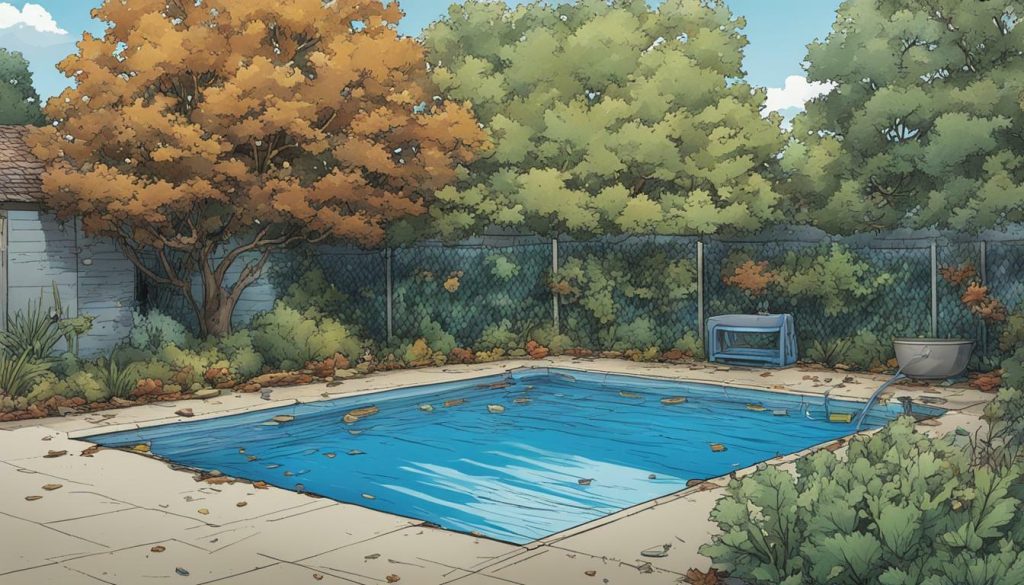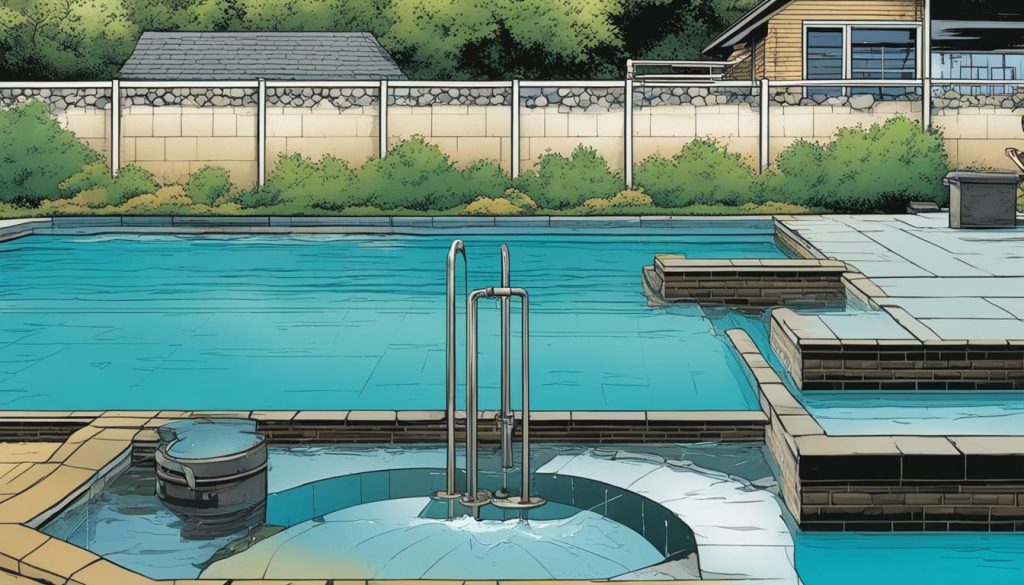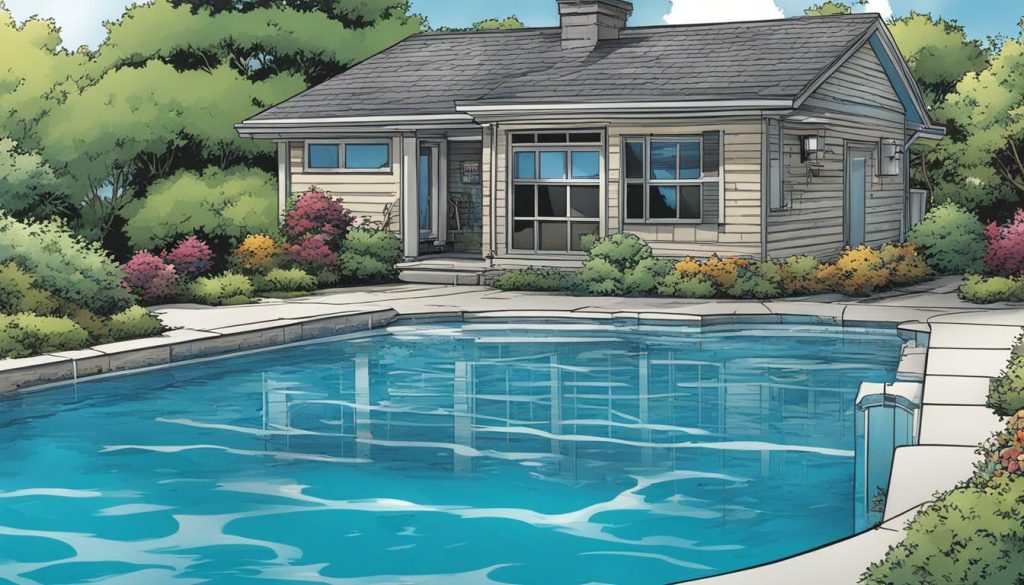Effective management of pool water levels is crucial for proper pool maintenance and ensuring a safe and enjoyable swimming experience. Maintaining the right water level not only helps to balance the pool’s water chemistry but also prevents damage to the pool’s equipment and surfaces. In this section, we will explore the importance of managing pool water levels and the steps you can take to keep your pool in optimal condition.
Key Takeaways:
- Regularly monitoring and managing pool water levels is essential for maintaining proper pool maintenance.
- Using a submersible sump pump is an effective method for lowering water levels in the pool.
- Refilling the pool correctly by testing and adjusting water chemistry is important for maintaining balance and cleanliness.
- Regular pool cleaning, shocking, and maintaining chlorine and cyanuric acid levels are key to ensuring optimal water quality.
- Maintaining pool water levels is crucial for preventing damage to pool equipment and surfaces.
Understanding Pool Water Evaporation
Pool water evaporation is a natural process influenced by factors such as temperature, humidity, wind, and pool usage. As water is exposed to the elements, it slowly transforms from a liquid state to vapor, causing the water level in your pool to decrease over time. Understanding this process is crucial for maintaining optimal pool water balance and circulation. By monitoring water levels regularly, you can prevent potential damage and ensure the longevity of your pool.
To effectively manage water evaporation, it is important to monitor your pool’s water level regularly. A simple method is to use a water level monitoring device or simply take regular measurements yourself. By doing so, you can identify any significant decrease in water levels, indicating excessive evaporation. In addition to monitoring, maintaining proper pool water circulation is crucial. Evaporation can lead to unbalanced water chemistry and poor circulation, which can negatively impact the overall cleanliness and quality of your pool.
Proper water circulation can be achieved through various methods, such as running your pool’s filtration system for an adequate number of hours each day. This ensures that the water is constantly circulating, preventing stagnation and reducing the likelihood of evaporation. Additionally, using pool covers when the pool is not in use can significantly reduce evaporation rates. This simple step helps to maintain water levels and reduce the need for excessive refilling.
In summary, understanding pool water evaporation is essential for effective pool maintenance. By monitoring water levels, maintaining proper circulation, and using pool covers, you can minimize the impact of evaporation on your pool. This keeps your pool water balanced, clean, and ready for a refreshing swim at any time.
Pool Water Evaporation Prevention Tips:
- Monitor water levels regularly to identify excessive evaporation
- Ensure proper pool water circulation by running the filtration system for sufficient hours each day
- Use pool covers when the pool is not in use to reduce evaporation rates
Image:

| Factors Influencing Pool Water Evaporation | Impact on Evaporation |
|---|---|
| Temperature | Higher temperatures increase evaporation rates |
| Humidity | Lower humidity levels increase evaporation rates |
| Wind | Higher wind speeds enhance evaporation |
| Pool Usage | Increased pool usage leads to greater evaporation |
Managing Water Levels with a Sump Pump

Renting a submersible sump pump from a home improvement store is an efficient way to control and maintain the water levels in your pool. With the right equipment and technique, you can easily manage the water balance and prevent damage caused by improper circulation.
To begin, set up the sump pump and discharge hoses, ensuring that the water is drained into a clean out or used to irrigate your lawn or plants. Lower the pump into the pool, plug it in, and carefully monitor the discharge. As the water level decreases, it’s essential to spray the perimeter of the pool with a hose to maintain proper water balance. Lastly, manually drain the remaining water with buckets once the pump has removed most of it.
Remember, managing water levels is just one aspect of pool maintenance. It’s crucial to regularly test and adjust the pool water chemistry to maintain a safe and balanced environment for swimming. Cleaning the pool at least once a week and shocking it at night will help eliminate contaminants and maintain water quality. Additionally, keeping proper chlorine levels and adjusting them as needed using chlorine tablets or a chlorine neutralizer is essential. Lastly, maintaining cyanuric acid levels at no higher than 40 ppm will prevent the sun from burning off the chlorine.
Refilling the Pool Properly
Once the pool has been drained to the desired level, it’s essential to refill it properly to ensure a balanced and healthy swimming environment. Start by connecting garden hoses to available spigots and drop them into the side of the pool. This allows for a steady flow of water into the pool.
While refilling, it’s important to let the water settle before adding any chemicals or additives. This allows any sediment or debris to settle at the bottom of the pool, making it easier to clean later on. It’s also advisable to test the alkalinity, pH, and calcium hardness of the water and adjust them as necessary before adding any additional chemicals.
Once the water has settled and the necessary adjustments have been made, it’s time to add chlorine, CYA (cyanuric acid), or salt to the pool. These chemicals help maintain proper water balance and disinfect the pool to prevent the growth of harmful bacteria and algae.
| Chemical | Amount |
|---|---|
| Chlorine | Adjust according to the manufacturer’s instructions |
| CYA | Maintain levels below 40 ppm |
| Salt | Follow the manufacturer’s guidelines for saltwater pools |
Maintaining proper chlorine levels is crucial for a clean and safe swimming experience. Regularly test the chlorine levels and adjust them as needed using chlorine tablets or a chlorine neutralizer. Additionally, it’s important to maintain CYA levels at no higher than 40 ppm to prevent the sun from burning off the chlorine too quickly. This helps ensure that the chlorine remains effective for longer periods.
By following these steps and regularly testing and adjusting the pool water chemistry, you can maintain a clean and balanced swimming pool that is enjoyable and safe for all. Remember to clean the pool at least once a week, shock the pool once a week at night to eliminate contaminants, and maintain proper chlorine and CYA levels. With proper maintenance and water level control, you can enjoy a refreshing swim all season long.

Maintaining Pool Water Chemistry
Achieving and sustaining proper pool water chemistry is crucial for preventing algae growth, maintaining water clarity, and ensuring swimmer comfort. To achieve this, it is essential to regularly test and adjust the pool water chemistry using the following steps:
- Test the Water: Use a reliable water testing kit to measure the alkalinity, pH, and calcium hardness of the pool water. These parameters directly affect the water’s balance and overall quality. Record the test results for future reference.
- Adjust Alkalinity and pH: If the alkalinity levels are too low or high, use the appropriate chemicals to bring it within the recommended range. Similarly, adjust the pH levels using pH increasers or decreasers to ensure it is balanced and stays between 7.2 and 7.8.
- Control Calcium Hardness: Calcium hardness refers to the amount of dissolved calcium in the water. High levels can lead to scaling on pool surfaces, while low levels can cause corrosion. Maintain calcium hardness between 200-400 ppm by adding calcium hardness increaser or using a calcium hardness decreaser if the levels are too high.
- Add Chlorine: Chlorine is crucial for disinfecting the pool water and killing harmful bacteria. Test the chlorine levels regularly and add chlorine tablets or liquid chlorine to maintain a level of 1-3 ppm.
- Maintain Cyanuric Acid Levels: Cyanuric acid (CYA) helps stabilize chlorine and protects it from degradation by the sun’s UV rays. Keep CYA levels between 30-50 ppm. If the levels are too high, dilute the water by partially draining and refilling the pool.
Along with maintaining proper pool water chemistry, it is important to clean the pool at least once a week to remove debris, leaves, and other contaminants. Additionally, shock the pool once a week at night to oxidize any organic matter and restore water clarity. Shocking involves adding a high dose of chlorine to the pool.
“Regular testing and adjustment of pool water chemistry is essential for a safe and enjoyable swimming experience. By following these steps, you can prevent algae growth, keep the water clear, and maintain optimal swimmer comfort.”

| Water Parameter | Recommended Range |
|---|---|
| Alkalinity | 80-120 ppm |
| pH | 7.2-7.8 |
| Calcium Hardness | 200-400 ppm |
| Chlorine | 1-3 ppm |
| Cyanuric Acid | 30-50 ppm |
Pool Cleaning and Shocking
Routine pool cleaning and shocking are essential steps in maintaining a clean and hygienic swimming pool. Regular maintenance not only ensures that the water is safe for swimming but also helps to prolong the life of the pool equipment. Here are some key steps to follow for effective pool cleaning and shocking:- Skim the surface: Use a skimmer net to remove leaves, debris, and insects from the surface of the water. This will prevent them from sinking to the bottom and causing stains.
- Brush the walls and floor: Use a pool brush to scrub the walls and floor of the pool. This will help to remove algae and other build-up that can make the pool look dirty and affect water clarity.
- Vacuum the pool: Use a pool vacuum to clean the pool’s floor and corners. This will remove any dirt and debris that have settled on the bottom.
- Shock the pool: Shocking the pool involves adding a high dose of chlorine or other sanitizers to kill bacteria, algae, and other contaminants. This should be done once a week, preferably at night when the sun won’t burn off the chlorine too quickly.
Importance of Pool Shocking
Shocking the pool is crucial because it helps to oxidize and remove organic matter that regular sanitizers may not eliminate. This process ensures that the water remains clear, bacteria-free, and safe for swimming. It also helps to break down chloramines, which can cause eye and skin irritation. By regularly shocking the pool, you maintain proper water balance and prevent the buildup of harmful substances.
Proper pool cleaning and shocking are essential for maintaining a beautiful and healthy swimming pool. Neglecting regular maintenance can result in cloudy water, algae growth, and even health risks. By following these steps and regularly checking and adjusting water chemistry, you can enjoy a clean and inviting pool all season long.
Summary
Regular pool cleaning and shocking are vital for keeping your pool safe and inviting. Skim the surface, brush the walls and floor, and vacuum the pool to remove debris and prevent stains. Don’t forget to shock the pool weekly to eliminate bacteria and maintain water clarity. By following these steps, you’ll ensure that your pool remains clean, hygienic, and ready for swimming enjoyment.| Step | Description |
|---|---|
| 1 | Skim the surface |
| 2 | Brush the walls and floor |
| 3 | Vacuum the pool |
| 4 | Shock the pool |
Maintaining Chlorine and Cyanuric Acid Levels
It is crucial to monitor and adjust chlorine and cyanuric acid levels to ensure the effectiveness of the sanitization process and prevent chlorine loss due to sunlight exposure. Maintaining the proper balance of these chemicals in your pool water is essential for maintaining clean and safe swimming conditions.
To maintain chlorine levels, you can use chlorine tablets or a chlorine neutralizer based on the readings from your pool water testing kit. Chlorine tablets slowly release chlorine into the water, helping to kill bacteria and algae. If the chlorine levels are too low, you can add more tablets to bring it back to the recommended range. Conversely, if the chlorine levels are too high, you can use a chlorine neutralizer to reduce the concentration.

Cyanuric acid, also known as CYA or stabilizer, helps to protect chlorine from being broken down by sunlight. However, it is important to keep the cyanuric acid levels within the recommended range of no higher than 40 parts per million (ppm). Excessive cyanuric acid can reduce the effectiveness of chlorine, leading to cloudy water and potential waterborne illnesses.
| Chemical | Recommended Range |
|---|---|
| Free Chlorine | 2-4 ppm |
| pH | 7.2-7.6 |
| Total Alkalinity | 80-120 ppm |
| Calcium Hardness | 200-400 ppm |
| Cyanuric Acid | 20-40 ppm |
Regularly test your pool water using a reliable testing kit and adjust the chlorine and cyanuric acid levels accordingly. By maintaining proper levels, you can ensure your pool stays clean, clear, and safe for swimming throughout the season.
Conclusion
Proper management of pool water levels is integral to maintaining a clean, safe, and enjoyable swimming pool environment. By following the recommended steps and regularly monitoring water levels, you can ensure the longevity and optimal performance of your pool.
To manage water levels in a pool, start by renting a submersible sump pump from a home improvement store. Set up the pump and discharge hoses, making sure to drain the water into a clean out or use it to irrigate your lawn or plants. Lower the pump into the pool, plug it in, and monitor the discharge carefully. As the water level decreases, spray the perimeter of the pool with a hose. When the pump has removed most of the water, manually drain the last bit with buckets.
To refill the pool, connect garden hoses to available spigots and drop them into the side of the pool. Wait for the water to settle before adding any chemicals or additives. Test the alkalinity, pH, and calcium hardness of the water and adjust them as necessary before adding chlorine, CYA, or salt. It’s important to regularly test and adjust the pool water chemistry, clean the pool at least once a week, and shock the pool once a week at night. It’s also important to maintain proper chlorine levels and adjust them as needed using chlorine tablets or a chlorine neutralizer. Lastly, maintain cyanuric acid levels at no higher than 40 ppm to prevent the sun from burning off the chlorine.
Why Is Proper Pool Water Level Important for Pool Cleaning?
Proper pool water level is crucial for effective pool cleaning. Maintaining the right water level ensures that the skimmers function optimally, removing debris from the surface. It also allows the pool equipment, such as pumps and filters, to operate efficiently. Follow these pool cleaning tips to avoid damage and ensure a cleaner pool.
FAQ
Why is managing pool water levels important?
Managing pool water levels is important to maintain proper circulation, prevent damage, and ensure optimal water balance and cleanliness.
What causes water evaporation in a pool?
Water evaporation in a pool is caused by factors such as heat, wind, and sun exposure. It can lead to water loss and imbalanced water chemistry.
How can I manage water levels in my pool using a sump pump?
Rent a submersible sump pump and set it up with discharge hoses. Lower the pump into the pool, plug it in, and monitor the discharge carefully. Use a hose to spray the perimeter of the pool as the water level decreases and manually drain the last bit with buckets.
What is the correct process for refilling a pool after managing the water levels?
Connect garden hoses to available spigots and drop them into the side of the pool. Wait for the water to settle before adding any chemicals or additives. Test the water alkalinity, pH, and calcium hardness, and adjust them as necessary before adding chlorine, CYA, or salt.
How often should I test and adjust the pool water chemistry?
It’s important to regularly test and adjust the pool water chemistry. Clean the pool at least once a week, shock the pool once a week at night, and maintain proper chlorine levels by using chlorine tablets or a chlorine neutralizer.
How should I maintain chlorine and cyanuric acid levels in my pool?
Maintain proper chlorine levels and adjust them as needed using chlorine tablets or a chlorine neutralizer. Also, maintain cyanuric acid levels at no higher than 40 ppm to prevent the sun from burning off the chlorine.

